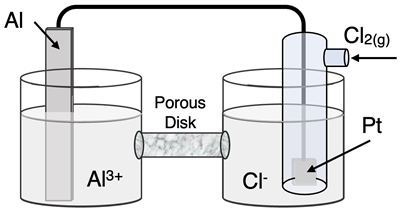Galvanic Cells - Questions
The Galvanic Cells Concept Builder is comprised of 24 questions organized into 12 Question Groups and spread across three difficulty levels. Each question requires the same task - completing the cell diagram for a galvanic cell.
Here is the breakdown of the difficulty levels:
- Apprentice Difficulty Level: Question Groups 1-4 ... Students are given contents of each half-cell and the balanced equation for the redox reaction. They must identify the half-equations, the anode and the cathode, and the direction of electron flow.
- Master Difficulty Level: Question Groups 5-8 ... Students are given contents of each half-cell and the balanced equation for the redox reaction. They must identify the half-equations, the anode and the cathode, the direction of electron flow, and the direction of positive/negative ion flow.
- Wizard Difficulty Level: Question Groups 9-12 ... Students are given contents of each half-cell and the balanced equation for the redox reaction. They must identify the half-equations, the anode and the cathode, the direction of electron flow, and the direction of positive/negative ion flow. Reactions are slightly more complex than the Master Level.
The questions from each group are shown below. Teachers are encouraged to view the questions in order to judge which difficulty levels are most appropriate for their classes. Alternatively, teachers can do the
Concept Builder to gain a feel for the student experience..
The Physics Classroom grants teachers and other users the right to print these questions for private use. Users are also granted the right to copy the text and modify it for their own use. However, this document should not be uploaded to other servers for distribution to and/or display by others. The Physics Classroom website should remain the only website or server from which the document is distributed or displayed. We also provide a PDF that teachers can use under the same conditions. We have included a link to the PDF near the bottom of this page.
Galvanic Cells
Apprentice Difficulty Level
Question Group 1
Question 1
The redox reaction for this galvanic cell is:
Cu2+(aq) + Fe(s) → Cu(s) + Fe2+(aq)
Complete the galvanic cell diagram by identifying the half equations occurring in each half-cell, identifying the half-cell where oxidation occurs and the half-cell where reduction occurs, labeling the anode and the cathode, and identifying the direction of electron flow in the wire.
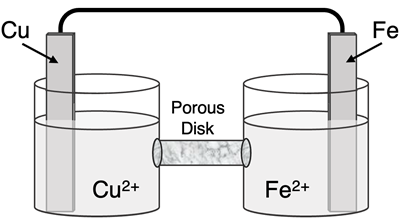
Question 2
The redox reaction for this galvanic cell is:
Fe(s) + Cu2+(aq) → Fe2+(aq) + Cu(s)
Complete the galvanic cell diagram by identifying the half equations occurring in each half-cell, identifying the half-cell where oxidation occurs and the half-cell where reduction occurs, labeling the anode and the cathode, and identifying the direction of electron flow in the wire.
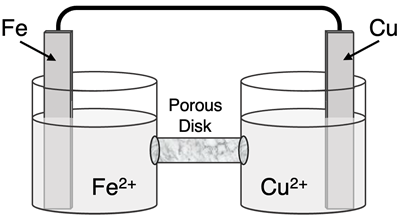
Question Group 2
Question3
The redox reaction for this galvanic cell is:
Cu2+(aq) + Zn(s) → Cu(s) + Zn2+(aq)
Complete the galvanic cell diagram by identifying the half equations occurring in each half-cell, identifying the half-cell where oxidation occurs and the half-cell where reduction occurs, labeling the anode and the cathode, and identifying the direction of electron flow in the wire.
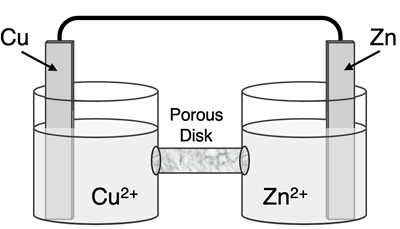
Question 4
The redox reaction for this galvanic cell is:
Zn(s) + Cu2+(aq) → Zn2+(aq) + Cu(s)
Complete the galvanic cell diagram by identifying the half equations occurring in each half-cell, identifying the half-cell where oxidation occurs and the half-cell where reduction occurs, labeling the anode and the cathode, and identifying the direction of electron flow in the wire.
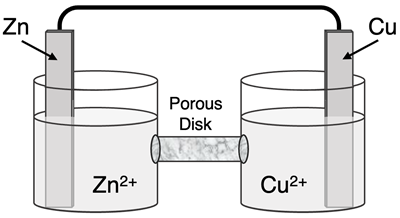
Question Group 3
Question 5
The redox reaction for this galvanic cell is:
Cu2+(aq) + Pb(s) → Cu(s) + Pb2+(aq)
Complete the galvanic cell diagram by identifying the half equations occurring in each half-cell, identifying the half-cell where oxidation occurs and the half-cell where reduction occurs, labeling the anode and the cathode, and identifying the direction of electron flow in the wire.
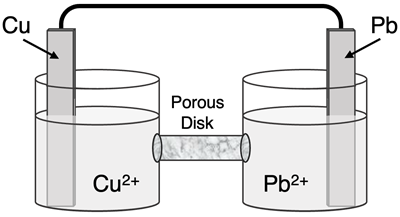
Question 6
The redox reaction for this galvanic cell is:
Pb(s) + Cu2+(aq) → Pb2+(aq) + Cu(s)
Complete the galvanic cell diagram by identifying the half equations occurring in each half-cell, identifying the half-cell where oxidation occurs and the half-cell where reduction occurs, labeling the anode and the cathode, and identifying the direction of electron flow in the wire.
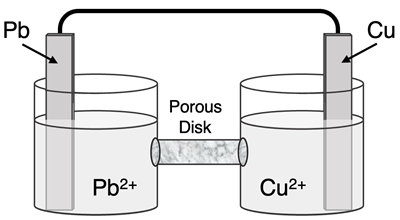
Question Group 4
Question 7
The redox reaction for this galvanic cell is:
Pb2+(aq) + Zn(s) → Pb(s) + Zn2+(aq)
Complete the galvanic cell diagram by identifying the half equations occurring in each half-cell, identifying the half-cell where oxidation occurs and the half-cell where reduction occurs, labeling the anode and the cathode, and identifying the direction of electron flow in the wire.
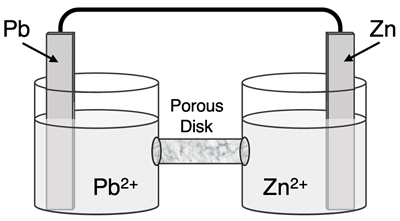
Question 8
The redox reaction for this galvanic cell is:
Zn(s) + Pb2+(aq) → Zn2+(aq) + Pb(s)
Complete the galvanic cell diagram by identifying the half equations occurring in each half-cell, identifying the half-cell where oxidation occurs and the half-cell where reduction occurs, labeling the anode and the cathode, and identifying the direction of electron flow in the wire.
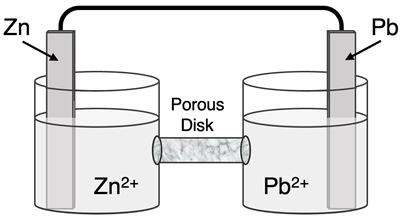
Master Difficulty Level
Question Group 5
Question 9
The redox reaction for this galvanic cell is:
Al(s) + Sn2+(aq) → Al3+(aq) + Sn(s)
Complete the galvanic cell diagram by identifying the half equations occurring in each half-cell, identifying the half-cell where oxidation occurs and the half-cell where reduction occurs, labeling the anode and the cathode, identifying the direction of electron flow in the wire, and identifying the direction of positive and negative ion flow through the porous membrane.
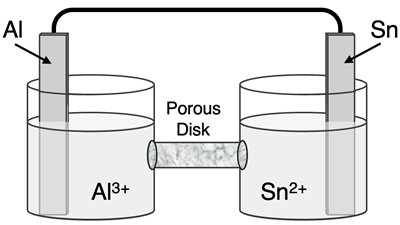
Question 10
The redox reaction for this galvanic cell is:
Sn2+(aq) + Al(s) → Sn(s) + Al3+(aq)
Complete the galvanic cell diagram by identifying the half equations occurring in each half-cell, identifying the half-cell where oxidation occurs and the half-cell where reduction occurs, labeling the anode and the cathode, identifying the direction of electron flow in the wire, and identifying the direction of positive and negative ion flow through the porous membrane.
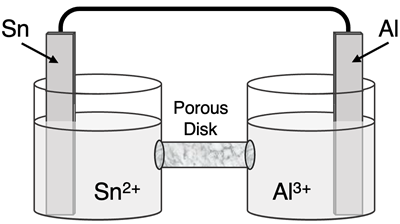
Question Group 6
Question 11
The redox reaction for this galvanic cell is:
Sn2+(aq) + Cr(s) → Sn(s) + Cr3+(aq)
Complete the galvanic cell diagram by identifying the half equations occurring in each half-cell, identifying the half-cell where oxidation occurs and the half-cell where reduction occurs, labeling the anode and the cathode, identifying the direction of electron flow in the wire, and identifying the direction of positive and negative ion flow through the porous membrane.
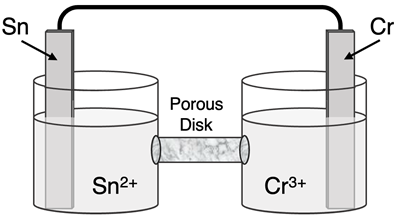
Question 12
The redox reaction for this galvanic cell is:
Cr(s) + Sn2+(aq) → Cr3+(aq) + Sn(s)
Complete the galvanic cell diagram by identifying the half equations occurring in each half-cell, identifying the half-cell where oxidation occurs and the half-cell where reduction occurs, labeling the anode and the cathode, identifying the direction of electron flow in the wire, and identifying the direction of positive and negative ion flow through the porous membrane.
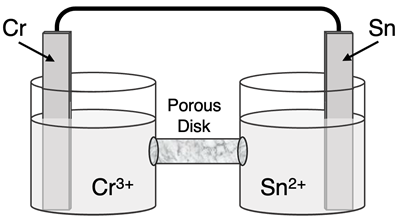
Question Group 7
Question 13
The redox reaction for this galvanic cell is:
Cr3+(aq) + Al(s) → Cr(s) + Al3+(aq)
Complete the galvanic cell diagram by identifying the half equations occurring in each half-cell, identifying the half-cell where oxidation occurs and the half-cell where reduction occurs, labeling the anode and the cathode, identifying the direction of electron flow in the wire, and identifying the direction of positive and negative ion flow through the porous membrane.
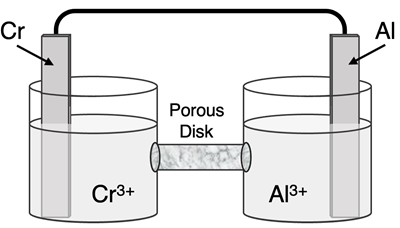
Question 14
The redox reaction for this galvanic cell is:
Al(s) + Cr3+(aq) → Al3+(aq) + Cr(s)
Complete the galvanic cell diagram by identifying the half equations occurring in each half-cell, identifying the half-cell where oxidation occurs and the half-cell where reduction occurs, labeling the anode and the cathode, identifying the direction of electron flow in the wire, and identifying the direction of positive and negative ion flow through the porous membrane.

Question Group 8
Question 15
The redox reaction for this galvanic cell is:
Sn2+(aq) + Mg(s) → Sn(s) + Mg2+(aq)
Complete the galvanic cell diagram by identifying the half equations occurring in each half-cell, identifying the half-cell where oxidation occurs and the half-cell where reduction occurs, labeling the anode and the cathode, identifying the direction of electron flow in the wire, and identifying the direction of positive and negative ion flow through the porous membrane.
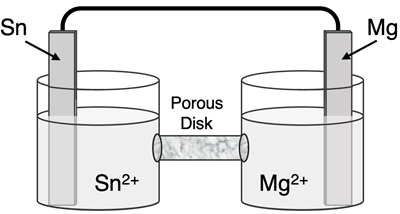
Question 16
The redox reaction for this galvanic cell is:
Mg(s) + Sn2+(aq) → Mg2+(aq) + Sn(s)
Complete the galvanic cell diagram by identifying the half equations occurring in each half-cell, identifying the half-cell where oxidation occurs and the half-cell where reduction occurs, labeling the anode and the cathode, identifying the direction of electron flow in the wire, and identifying the direction of positive and negative ion flow through the porous membrane.
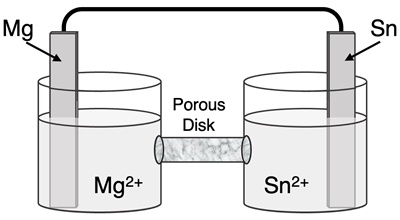
Wizard Difficulty Level
Question Group 9
Question 17
The redox reaction for this galvanic cell is:
F2(g) + Cu(s) → 2 F-(aq) + Cu2+(aq)
Complete the galvanic cell diagram by identifying the half equations occurring in each half-cell, identifying the half-cell where oxidation occurs and the half-cell where reduction occurs, labeling the anode and the cathode, identifying the direction of electron flow in the wire, and identifying the direction of positive and negative ion flow through the porous membrane.
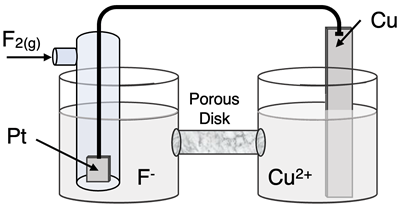
Question 18
The redox reaction for this galvanic cell is:
Cu(s) + F2(g) → Cu2+(aq) + 2 F-(aq)
Complete the galvanic cell diagram by identifying the half equations occurring in each half-cell, identifying the half-cell where oxidation occurs and the half-cell where reduction occurs, labeling the anode and the cathode, identifying the direction of electron flow in the wire, and identifying the direction of positive and negative ion flow through the porous membrane.
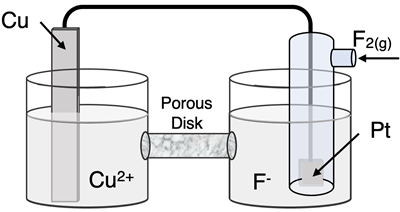
Question Group 10
Question 19
The redox reaction for this galvanic cell is:
3 Cl2(g) + 2 Cr(s) → 6 Cl-(aq) + 2 Cr3+(aq)
Complete the galvanic cell diagram by identifying the half equations occurring in each half-cell, identifying the half-cell where oxidation occurs and the half-cell where reduction occurs, labeling the anode and the cathode, identifying the direction of electron flow in the wire, and identifying the direction of positive and negative ion flow through the porous membrane.
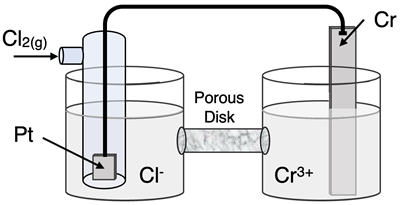
Question 20
The redox reaction for this galvanic cell is:
2 Cr(s) + 3 Cl2(g) → 2 Cr3+(aq) + 6 Cl-(aq)
Complete the galvanic cell diagram by identifying the half equations occurring in each half-cell, identifying the half-cell where oxidation occurs and the half-cell where reduction occurs, labeling the anode and the cathode, identifying the direction of electron flow in the wire, and identifying the direction of positive and negative ion flow through the porous membrane.
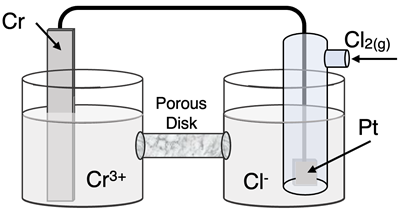
Question Group 11
Question 21
The redox reaction for this galvanic cell is:
2 H+(aq) + Zn(s) → H2(g) + Zn2+(aq)
Complete the galvanic cell diagram by identifying the half equations occurring in each half-cell, identifying the half-cell where oxidation occurs and the half-cell where reduction occurs, labeling the anode and the cathode, identifying the direction of electron flow in the wire, and identifying the direction of positive and negative ion flow through the porous membrane.
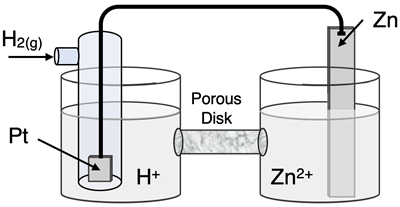
Question 22
The redox reaction for this galvanic cell is:
Zn(s) + 2 H+(aq) → Zn2+(aq) + H2(g)
Complete the galvanic cell diagram by identifying the half equations occurring in each half-cell, identifying the half-cell where oxidation occurs and the half-cell where reduction occurs, labeling the anode and the cathode, identifying the direction of electron flow in the wire, and identifying the direction of positive and negative ion flow through the porous membrane.
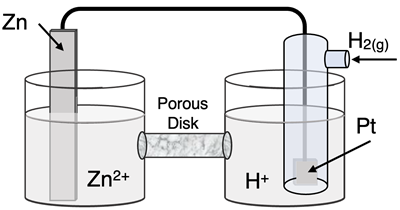
Question Group 12
Question 23
The redox reaction for this galvanic cell is:
3 Cl2(g) + 2 Al(s) → 6 Cl-(aq) + 2 Al3+(aq)
Complete the galvanic cell diagram by identifying the half equations occurring in each half-cell, identifying the half-cell where oxidation occurs and the half-cell where reduction occurs, labeling the anode and the cathode, identifying the direction of electron flow in the wire, and identifying the direction of positive and negative ion flow through the porous membrane.
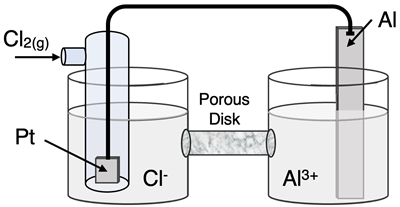
Question 24
The redox reaction for this galvanic cell is:
2 Al(s) + 3 Cl2(g) → 2 Al3+(aq) + 6 Cl-(aq)
Complete the galvanic cell diagram by identifying the half equations occurring in each half-cell, identifying the half-cell where oxidation occurs and the half-cell where reduction occurs, labeling the anode and the cathode, identifying the direction of electron flow in the wire, and identifying the direction of positive and negative ion flow through the porous membrane.
